June 24, 2025
Six Core Insights from the LED Revolution

Study traces LED progress through efficiency, scale and research
What actually drives technological progress? For the LED industry, the answer wasn’t what many assumed. A recently published study in Nature Energy traces 17 years of innovation in warm white LEDs and finds that the biggest leaps didn’t come from research labs — but from manufacturing lines. Between 2003 and 2020, efficiency surged and costs plummeted. But it was scale, not solely science, that lit the path forward.
Researchers from Cambridge, ETH Zurich, and Harvard Kennedy School break down that progress with surgical precision, dissecting how production experience, cross-sector insights, and targeted R&D each played a role. The result is a rare roadmap of innovation that challenges long-held narratives in both lighting and broader clean tech.
Their findings show that LED package efficiency increased from 5.8% to 38.8% over the 17-year span — a more than fivefold improvement. At the same time, manufacturing costs for low-to-mid-power LED packages fell by 95.5%, from $1.11 to just $0.05. The study breaks new ground by attributing these gains to specific innovation mechanisms, including learning by doing, R&D, and technology spillovers from other industries.
1. The Economics of Light: Cheap, but Not Because of Labs
The dramatic cost drop in LED manufacturing — 95.5% over 17 years — was not primarily driven by research breakthroughs, the study finds. Instead, improvements in manufacturing yields and economies of scale, such as increasing sapphire wafer diameters, did most of the work. These changes reflect cumulative production experience and investment in scaling, rather than targeted R&D.
This diverges from what many in the lighting and semiconductor sectors might expect. While R&D has often been framed as the engine of cost innovation, the data in this case highlight the potency of industrial learning and volume production efficiencies.
2. Where R&D Mattered Most: Quality and Performance
While cost savings came from process refinement, R&D played a dominant role in enhancing LED light quality. The study attributes most improvements in internal quantum efficiency, color rendering index (CRI), and tunable correlated color temperature (CCT) to R&D efforts — often those supported by public funding or academic-industry collaboration.
For lighting professionals, this distinction is essential. If you're designing products where color quality, tunability, and spectral performance matter, the evidence suggests that R&D remains a central driver of progress.
3. The People and Institutions Behind the Progress
The study draws on interviews with experts across academia and industry, many with ties to companies like OSRAM, GE Lighting, and Nichia. These companies appear frequently in the patent literature and commercialization timelines, but the research credits a wide range of contributors — particularly mission-driven public R&D programs and interdisciplinary research teams.
The collaborative nature of these advances highlights the role of shared knowledge networks and public-private partnerships in shaping lighting technology.
4. Innovation by Osmosis: How Spillovers Shaped LEDs
Among the most striking conclusions: at least 8.5% of the total efficiency improvement in LEDs between 2003 and 2020 stemmed from technology spillovers — the transfer of knowledge or techniques from other fields into LED development. Nearly all consumer-facing improvements in CRI and CCT came from outside lighting, such as CRT display phosphors, materials chemistry, and optical engineering.
Rather than suggesting a deficit in lighting R&D, the authors describe a system where LED innovation has been enriched by adjacent disciplines. From quantum dots to narrow-band red phosphors, the study highlights how expertise developed in other industries found new life in lighting applications.
5. Physical Limits Are Now in Sight
Several sub-efficiencies within LED packages — such as internal quantum efficiency, droop efficiency, and light extraction — are now approaching within 10 percentage points of their theoretical physical limits. This suggests that future efficiency gains will be harder to achieve and more expensive to pursue.
Only spectral efficiency shows notable room for improvement, offering one of the few remaining frontiers for fundamental performance gains.
6. Faster Than Any Lighting Tech in History
The researchers estimate that LED luminous efficacy has increased by 10 lumens per watt per year, making it the fastest-evolving lighting technology in recorded history. That rate surpasses even compact fluorescents and high-intensity discharge lamps.
This rapid advancement, paired with falling prices and improved quality, helps explain why LEDs now dominate new lighting installations globally. Yet it also implies that the pace of progress may soon slow, shifting focus to system-level design, control strategies, and integration with building technologies.
Progress and Innovation
The progress of white LED lighting over the past two decades emerges not as the result of a single breakthrough or isolated genius, but as a tapestry woven from R&D, production scale, and cross-disciplinary insights. The researchers emphasize the value of public research funding, long-term academic–industry partnerships, and openness to external knowledge as key enablers.
Their analysis offers a data-driven template for other demand-side energy technologies. As sectors from HVAC to electric cooking look to emulate the LED story, this study shows what it takes to combine scientific ambition with commercial viability — and why no sector innovates in a vacuum.
Study citation:
“Rapid technological progress in white light-emitting diodes and its source in innovation and technology spillovers” Published in Nature Energy, Volume 10, Pages 616–629 (April 25, 2025)
Authors:
- Michael P. Weinold – ETH Zurich; PSI Villigen; University of Cambridge
- Sergey Kolesnikov – University of Cambridge
- Laura Díaz Anadón – Harvard Kennedy School; University of Cambridge










